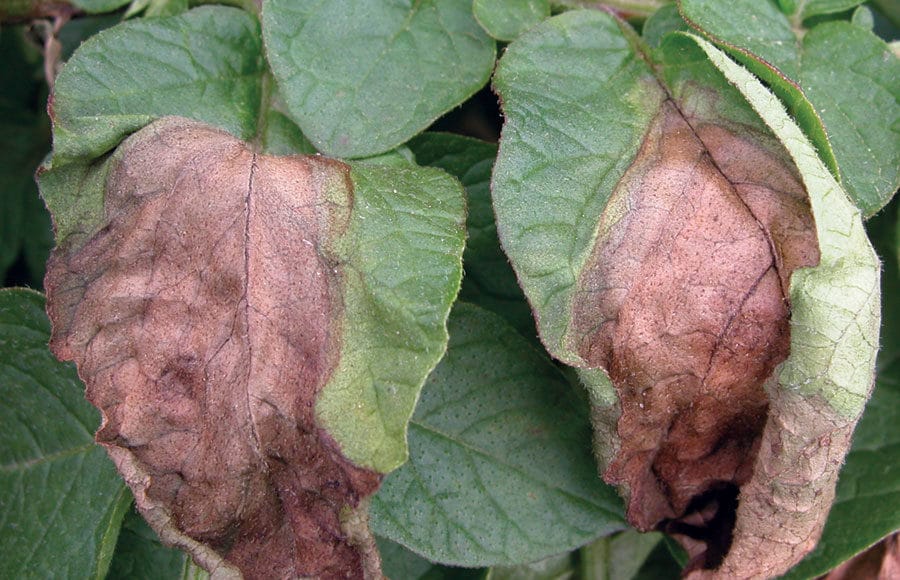Potato late blight is a devastating disease of potatoes. It can destroy a potato field in a few days if wet weather prevails and no effective fungicides are applied.
This is a “community disease” because late blight spores are spread by wind from infected to healthy fields. Thus, the management practices followed by individual growers will affect an entire potato production area.
Late blight is carried over from one season to the next by infected tubers — seed potatoes, cull potatoes — or volunteers.
The best defence is to avoid or delay the establishment of late blight. Planting healthy seed, destroying cull piles and volunteers, spraying early and regular field scouting should allow you to manage late blight without serious losses.
Sanitation Practices
Destroying cull piles and volunteers before the crop emerges eliminates sources of spores that can infect the crop during the season.
Field Spraying
Begin spraying early, when plants are 12-15 cm tall. If there is any indication the seed might be infected, spray Curzate twice: at 75 per cent emergence and again at 100 per cent emergence. Curzate has a kick-back effect of 36 hours.
Spray intervals may need to be as short as four days if the weather is conducive to late blight and disease pressure is high. If warm, dry weather prevails, intervals can be extended according to crop growth. Spraying should be more frequent when the canopy is developing rapidly.
Make sure spray coverage is even on the canopy. Put sticky paper disks sensitive to pH in the canopy to evaluate spray coverage.
Pressure wash your farm equipment after using it in an infected field.
Field Scouting
Late blight is much easier to control if found early. Start scouting as soon as the crop starts to emerge. Some areas of the field will be at higher risk of blight: low spots, compacted areas, rows close to tree lines, field edges along creeks or ponds, pivot center points, pivot wheel tracks and weedy areas. Scout these areas thoroughly.
Destroy hot spots. It takes three or four days for infected plants to develop symptoms, so destroy all diseased plants and a six foot border of surrounding plants. You can pull and bag the diseased plants, spray them with a herbicide or disk the area. If you decide to disk the hot spot, spray the crop with a fungicide before disking to avoid spreading spores on farm equipment.
Top-killing and Harvest
Apply copper-based fungicides after top-killing the vines to make sure there are no viable spores at harvest.
Dig samples of tubers from areas with late blight before digging the whole field. Do not harvest areas where you found more than two per cent tuber infection. If you harvest those areas, market the crop as soon as possible.
Harvest when vines are completely dead. Apply phosphorous acid as a post-harvest treatment to reduce the spread of late blight in storage.
New Strains of Late Blight
New strains of late blight are developing very quickly. Some of these new strains may be susceptible to Ridomil. Others can be quite resistant. Unfortunately, it takes time to have infected leaves/stems analyzed for strain identification. Dr. Larry Kawchuk from the University of Lethbridge can identify late blight strains. He can be reached via email at [email protected].











